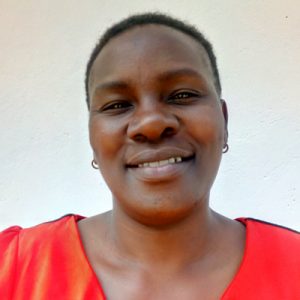"As a school administrator, I feel like I have let my school down by not having water in the school," said Mr. Macdaff Lutomia Wamalwa, the principal at Ebubole Secondary School.
"Water is life and a school cannot run without water. Whenever these students look at me with exhaustion it really makes my heart bleed. We really need this project!"
Ebubole Secondary School was established in 2014 to meet the need for students who had completed primary school and could not afford the nearby secondary boarding schools. Ebubole Secondary is a community school sponsored by the United Pentecostal Church (UPC) and located next to Ebubole Primary School. (We are working with the primary school to see if we can help relieve their water crisis, too). The surrounding area is filled with homesteads where at the time of writing, people were busy at work planting their second season of maize for the year.
Ebubole Secondary and its 269 students and 19 teachers and staff have really suffered for a while with no water on the school compound. Fetching water from the nearby spring is a part of the daily routine for the students.
The normal school session begins at 7:00 am when students begin their routine for fetching water from the spring, washing the latrines, sweeping classrooms, and sweeping the compound. At 8:00 am classes begin with 2 breaks before lunch, then after lunch classes resume from 2:00 pm to 4:00 pm. After classes end, some students are assigned to wash the classrooms while others go for games and club sessions depending on the school calendar and day of the week. Normally the day ends at 5:00 pm, with the exception of Wednesdays when students go to fetch water again in the evening in preparation for their early church services on Thursday mornings.
A hand-dug well with a pump previously installed saw the school excited that their water problem had been solved, only to be let down after the well went dry shortly after construction. Ever since then, the students have been forced to go back to their original water source at school: a spring 500 meters away that is shared with community members.
The spring was protected over 20 years ago. Over the past few years, some community members planted eucalyptus trees around the site, which require large amounts of water to grow and have subsequently reduced the spring's yield, increasing the amount of time it takes to fill up each container.
The students are always complaining because they are required to fetch water from the spring every morning. This, in turn, wastes their valuable time for morning preps when they should be studying and reviewing their work.
The students often become sick with the common cold because of the energy spent collecting water from a source that is not properly maintained. Community members are frustrated with the students at the spring who lengthen the line for fetching water. And they also blame the children for issues that arise at the spring. The 2 groups are often at odds for who gets to collect water first.
"I should be concentrating on my morning preps [but] instead I waste a lot of time fetching water from this spring. Before I came to this school I had no chest pains but nowadays chest pains and headaches are common. It is affecting me so much," said 17-year-old student Saumu.
The quality of the water students fetch is then compromised by its handling. Without any practices in place to treat the water back at school, dirty containers and hands that go without handwashing mean that students contract water-related diseases such as amoeba and typhoid. Those with no shoes at the spring contract bilharzia because of the poor drainage system. Students complain of headaches, colds, and the flu, not to mention the chest, body, and arm pains associated with carrying their heavy containers across the hilly landscape every day. All of these can lead to missed days of school that negatively impact the students' progression and performance.
Other problems associated with students fetching water at the spring is their lateness to class when fetching water takes a long time, and absenteeism due to some students avoiding coming in the day they know their class has been assigned to fetch water. Others deliberately delay whenever they are sent for water at the spring, wasting precious class time.
What we can do:
Rain Tank
A 75,000-liter rainwater catchment tank will help alleviate the water crisis at this school. The school will help collect the needed construction materials such as sand, bricks, rocks, and water for mixing cement. We will complement their materials by providing an expert team of artisans, tools, hardware, and the guttering system. Once finished, this tank will begin catching rainfall that will be used by the school’s students and staff for drinking, handwashing, cooking, cleaning, and much more.
We and the school strongly believe that all of these components will work together to improve standards at this school, which will help lead to better student academic performance and will help unlock the opportunity for these students to live better, healthier lives.
Handwashing Stations
We noticed 3 handwashing stations already present at Ebubole Secondary School. The one for the teachers had soap but the 2 for students had no soap or ash and are located near the kitchen, which means that the sensitization and practice of handwashing at other critical points are wanting, especially outside the latrines.
The student health club will oversee the 2 new handwashing stations we will provide in addition to the 3 already present on campus, and make sure they are kept clean and in working condition. The club leaders will fill the handwashing stations with water daily and make sure they are always supplied with a cleaning agent such as soap or ash.
VIP Latrines
A pair of triple-door latrine blocks will be constructed with local materials that the school will help gather. 3 doors will serve the girls while the other 3 will serve the boys. All of these new latrines will have cement floors that are designed to be easy to use and to clean. And with a rain tank right on school property, there should be enough water to keep them clean.
Training
We will hold a 1-day intensive training on improved hygiene, health, and sanitation habits at this school. Our team of facilitators will use a variety of methods to train students and staff, including participatory hygiene and sanitation transformation (PHAST) and asset-based community development (ABCD). We will initiate a child-to-child (CTC) student health club, which will prepare students to lead other pupils into healthy habits at school and at home. We will also lead lectures, group discussions, and provide illustrative handouts to teach health topics and ways to promote good hygiene practices within the school. We will then conduct a series of follow-up trainings before transitioning to our regularly scheduled support visits throughout the year.

 Rainwater Catchment
Rainwater Catchment
 Rehabilitation Project
Rehabilitation Project



















































